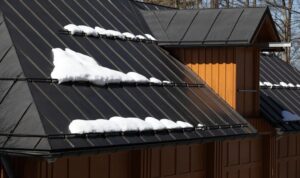Delving into the impact of climate on roofing choices, this introduction immerses readers in a unique and compelling narrative. It explores how climate conditions play a crucial role in determining the most suitable roofing materials for different environments, shedding light on the importance of making informed decisions.
As we navigate through the intricate relationship between climate and roofing choices, it becomes evident that the selection of materials goes beyond aesthetics, encompassing factors like durability, environmental impact, energy efficiency, and maintenance requirements.
Factors influencing roofing material choices
When it comes to choosing the right roofing material, there are several factors that come into play. Climate conditions are one of the key considerations that impact the choice of roofing materials. Different types of roofing materials are commonly used based on the specific climate of the region.
Commonly used roofing materials
- Asphalt shingles: Widely used due to their affordability and versatility.
- Metal roofing: Durable and long-lasting, suitable for various climates.
- Clay tiles: Ideal for hot and dry climates, providing excellent insulation.
- Wood shakes: Popular in areas with mild climates, offering a natural look.
Roofing materials suitable for different climates
Depending on the climate conditions, certain roofing materials are more suitable than others. For example:
- Hot and dry climates:Clay tiles are a great choice as they provide excellent insulation and can withstand high temperatures.
- Cold and snowy climates:Metal roofing is ideal for areas with heavy snowfall as it sheds snow easily and is durable against harsh winter conditions.
- Mild climates:Wood shakes are commonly used in regions with moderate temperatures, providing a natural and aesthetic appeal.
Environmental impact of roofing choices
Roofing materials play a significant role in the environmental impact of buildings. The type of material used can affect energy consumption, greenhouse gas emissions, and overall sustainability of the structure.
Eco-friendly roofing options and their benefits
There are several eco-friendly roofing options available that can help reduce the environmental impact of buildings. These options often provide benefits such as energy efficiency, durability, and improved indoor air quality. Some examples of sustainable roofing materials include:
- Green roofs: These roofs are covered with vegetation, which helps reduce heat absorption, improve air quality, and provide habitat for wildlife.
- Solar panels: Solar panels can be integrated into roofing materials to generate renewable energy and reduce reliance on fossil fuels.
- Metal roofs: Metal roofing is durable, recyclable, and energy-efficient, making it a sustainable choice for many buildings.
- Recycled materials: Using recycled materials, such as rubber or plastic, for roofing can help reduce waste and minimize the environmental impact of construction projects.
These eco-friendly roofing options not only benefit the environment but also provide cost savings and long-term sustainability for building owners.
Impact of sustainable roofing materials on the environment
Sustainable roofing materials have a positive impact on the environment by reducing energy consumption, lowering greenhouse gas emissions, and promoting resource conservation. By choosing sustainable roofing options, buildings can contribute to mitigating climate change and creating healthier, more sustainable communities.
Durability and maintenance considerations
In choosing roofing materials, it is crucial to consider the durability and maintenance requirements, especially in relation to the climate of the area where the property is located. Different roofing materials have varying levels of durability and maintenance needs depending on the climate they are exposed to.
Effect of Climate on Durability
The climatic conditions, such as temperature fluctuations, UV exposure, heavy rainfall, snow, and high winds, can significantly impact the durability of roofing materials. For example, asphalt shingles may deteriorate faster in hot and sunny climates due to UV exposure, while metal roofs can withstand extreme weather conditions better.
Maintenance Requirements in Different Climates
- In hot and sunny climates, regular inspection and maintenance of asphalt shingles are necessary to prevent cracking and warping.
- In areas with heavy rainfall, proper drainage systems and regular gutter cleaning are essential to prevent water damage to the roof structure.
- In regions prone to snow and ice, maintaining proper insulation and ventilation is crucial to prevent ice dams and water infiltration.
- In windy areas, securing loose components and inspecting for any damage after storms are important maintenance tasks.
Tips for Maintaining Roofs Based on Climate Conditions
- Regularly inspect your roof for any signs of damage, such as missing shingles, cracks, or leaks, and address them promptly.
- Clean debris, leaves, and branches off the roof to prevent water accumulation and potential damage.
- Trim overhanging tree branches to prevent them from rubbing against the roof and causing abrasion or damage.
- Consider applying protective coatings or sealants to extend the lifespan of your roofing material in harsh climate conditions.
Energy efficiency and insulation

Roofing materials play a crucial role in the energy efficiency of a building. The right choice of roofing material can significantly impact the amount of heat that enters or escapes from a structure, thus affecting energy consumption for heating and cooling.
Influence of climate on roofing materials for insulation
Climate is a key factor influencing the choice of roofing materials for insulation. In colder climates, roofs need to retain heat inside the building to reduce energy consumption for heating. In contrast, in hotter climates, roofs should reflect sunlight and heat to maintain a cooler indoor temperature.
- For cold climates, materials like metal roofs with insulation or asphalt shingles with high thermal mass can help retain heat inside the building, reducing the need for heating.
- In hot climates, reflective roofing materials like white membranes, metal roofs with reflective coatings, or clay tiles can help reduce heat absorption and keep the building cool, lowering the demand for air conditioning.
Energy-efficient roofing options and impact on energy consumption
There are several energy-efficient roofing options available that can help reduce energy consumption and lower utility bills.
- Green roofs, which involve planting vegetation on the roof surface, provide natural insulation, reduce heat absorption, and improve air quality.
- Solar panels integrated into the roofing system can harness renewable energy from the sun, reducing reliance on grid electricity and lowering carbon emissions.
- Cool roofs with reflective coatings or materials can reflect sunlight and heat away from the building, reducing the need for air conditioning and decreasing energy consumption.
Last Point
In conclusion, the impact of climate on roofing choices is a multifaceted issue that demands careful consideration and informed decision-making. By understanding the nuances of how climate conditions influence the selection of roofing materials, individuals can make sustainable choices that not only meet their needs but also contribute to a greener future.
Key Questions Answered
How does climate affect the choice of roofing materials?
Climate influences the choice of roofing materials by determining factors such as durability, energy efficiency, and maintenance requirements. For example, in areas with high precipitation, materials with high water resistance are preferred.
What are some eco-friendly roofing options?
Eco-friendly roofing options include materials like solar shingles, green roofs, and metal roofs made from recycled materials. These options offer sustainability benefits while reducing environmental impact.
How do roofing materials contribute to energy efficiency?
Roofing materials impact energy efficiency by providing insulation that helps regulate indoor temperature, reducing the need for heating and cooling. Materials with high thermal resistance are more energy-efficient.






